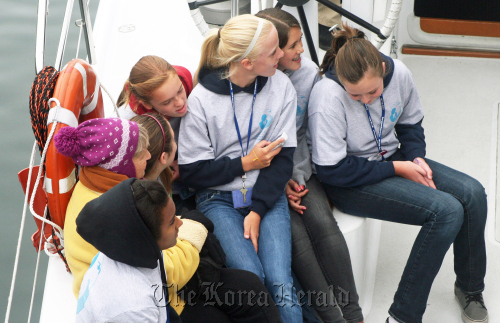MONETEREY, California ― For an instant, it seemed like a scene from a Hollywood pirate movie.
A ship at sea changes course when a mate cries out that she’s spotted something in the water. With all hands on deck, the crew uses a net to haul in the prize, and a chorus of cheers goes up at the sight of the bounty.
The treasure? A wrapper from a Teddy Grahams cookie package. The crew? Seventeen young girls on their first day at Camp SEA Lab, who were sailing last week in Monterey Bay while studying the issue of marine debris.
“One piece at a time!” a member of the camp crew calls out, eagerly anticipating the next bit of flotsam.
A ship at sea changes course when a mate cries out that she’s spotted something in the water. With all hands on deck, the crew uses a net to haul in the prize, and a chorus of cheers goes up at the sight of the bounty.
The treasure? A wrapper from a Teddy Grahams cookie package. The crew? Seventeen young girls on their first day at Camp SEA Lab, who were sailing last week in Monterey Bay while studying the issue of marine debris.
“One piece at a time!” a member of the camp crew calls out, eagerly anticipating the next bit of flotsam.

Camp SEA Lab ― “Science, Education & Adventure” ― offers a series of summer programs, in conjunction with California State University Monterey Bay, that utilize educational resources on the Central Coast. The young science enthusiasts on last week’s excursion were from the “Girls Love Science Too” camp, which attracts girls ages 13 to 16 from across California.
“We really would like to encourage girls to follow science as a career choice,” explained program director Amity Wood. “I think now more than ever there is a great opportunity for girls to explore science, which traditionally has been dominated by men.”
For the first day of camp, the young girls boarded a 65-foot vessel owned by the Sealife Conservation organization, whose scientists lectured campers about ocean pollution during their two-hour ride.
The nonprofit group has spent four years documenting trash buildup in the northern Pacific Ocean.
While the young girls occasionally let out shrieks of excitement or clung to the boat’s rails as it rocked with the waves, most of the trip was smooth sailing. They learned about a range of ocean conservation issues, including the harmful effects of plastic waste on marine life, and efforts that have been taken to curb pollution.
“We’re the generation that’s going to inherit this problem, so it’s important that we learn as much as we can so that we can protect the sea animals,” said Alexis Kelley-Macok, a 16-year-old camper from Los Gatos, Calif.
One highlight of the day occurred when the boat passed by a rare mola mola, or ocean sunfish, which can weigh over one ton. Tying the experience back to marine debris, the camp instructors explained that the huge creatures often eat plastic, which they mistake for jellyfish.
The five female camp instructors on-board explained that the camp’s title, “Girls Love Science Too,” makes an important social statement to young women at an impressionable age.
“In elementary school girls are equally interested in math and science,” said instructor Lauren Gamblin, “but just at the age when girls are entering high school, there is a big drop off. Programs like this can give girls opportunities to become stronger and gain the confidence to pursue studying science.”
According to a study by the American Association of University Women, the long-standing stereotype that men possess a biological advantage in math and science has been called into question by recent evidence. “When test administrators tell students that girls and boys are equally capable in math,” a 2010 report states, “the difference in performance essentially disappears, illustrating that changes in the learning environment can improve girls’ achievements in math.”
David Robinson, managing director of Sealife Conservation, said the conservation campaign would benefit from adding more women to its ranks.
“We find that when dealing with issues like marine debris, women have a greater ability to be compassionate,” Robinson said, “which is an incredibly important trait when dealing with conservation.”
For Monday’s voyage, the group set sail from Fisherman’s Wharf, where Robinson said some of the worst local ocean pollution occurs.
He explained that until just a few years ago, thousands of small plastic chowder dishes that restaurants used for free samples would find their way into the bay after being discarded. Now, after receiving pressure from groups such as Robinson’s, most restaurants have turned to reusable chowder dishes.
By Danny Funt, The Monterey County Herald
(McClatchy-Tribune Information Services)








![[Kim Seong-kon] Democracy and the future of South Korea](http://res.heraldm.com/phpwas/restmb_idxmake.php?idx=644&simg=/content/image/2024/04/16/20240416050802_0.jpg&u=)







![[KH Explains] Hyundai's full hybrid edge to pay off amid slow transition to pure EVs](http://res.heraldm.com/phpwas/restmb_idxmake.php?idx=652&simg=/content/image/2024/04/18/20240418050645_0.jpg&u=20240418181020)

![[Today’s K-pop] Zico drops snippet of collaboration with Jennie](http://res.heraldm.com/phpwas/restmb_idxmake.php?idx=642&simg=/content/image/2024/04/18/20240418050702_0.jpg&u=)